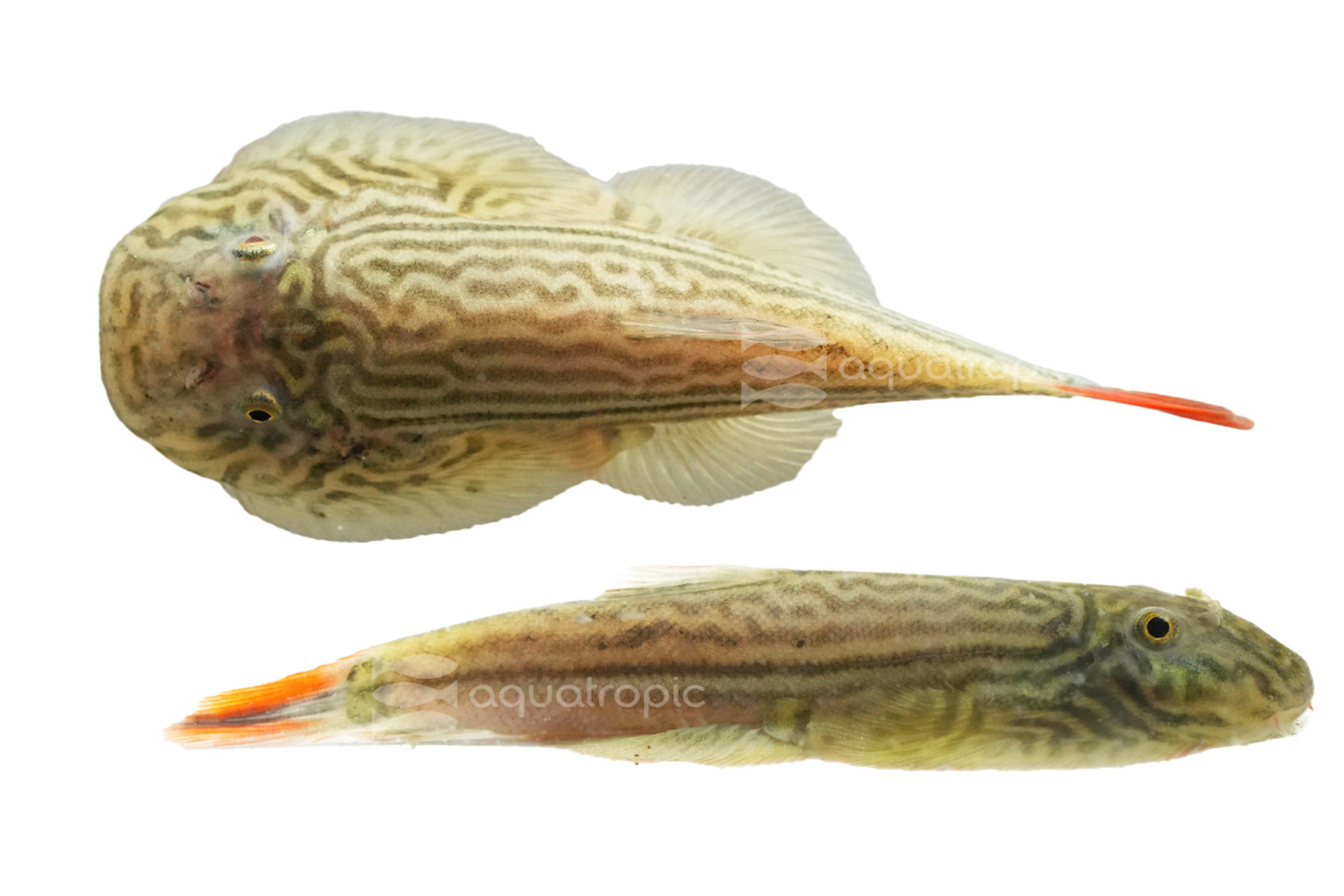Double Reds

Double Red Tail Borneo Suckers and indeed all of the other fish in the Gastromyzon genus are often called Hillstream Loaches, Sucker Loaches, and Butterfly Loaches and all these names are appropriate. They are also sometimes referred to as mini rays, or freshwater rays, which is not appropriate. All these Loaches / Suckers do have a flattened shape, and an interesting swimming style, so if someone was looking for a “ray” for a smaller aquarium, using fish in this genus to mimic that body shape is probably your only real choice.
Gastromyzon as a genus holds almost 50 fish, nearly all of which have been seen in an aquarium at one time or another. They are all amazing, beautiful fish, though they can be difficult to separate out by species because the differences between them can be as small as how many rays an individual fin has. Gastro is a reference to stomach, and myzon is a reference to suckling, and basically all these fish are called stomach suckers.
The Double Red Tail Borneo Suckers come from fast flowing, clear streams in Borneo that are generally shallow and very well oxygenated. Their "stomach sucker" shape allows them to point themselves into the fast flow of their native homes and still stay attached to the rocks while grazing on the bio films that are growing there. They tend to choose the most highly oxygenated areas of rivers, choosing shallow riffles and waterfall washouts. This behavior is the key to keeping them successfully.
The easiest way to keep oxygen levels high in an aquarium is to maintain high overturn and keep the temperature low. To this end, we suggest having a very large filter, one capable of turning over the entire volume of your display at least 15 times per hour, and more would be fine. You could also use powerheads and / or other flow devices to generate surface agitation, and the flow generated would also be well appreciated by the Double Red Tail Borneo Suckers. Forced oxygenation with sintered stones is also a great way to keep oxygen levels as high as possible. While a cursory glance around the internet will tell you these fish can be kept in water up to 80 degrees, we suggest keeping them cooler than this, and the low 70s or even high 60s will make it vastly easier to maintain higher oxygen levels in your display. Other water quality parameters are fairly easily provided for. They like slightly acidic water, that is low in nutrients (which also helps keep oxygenation high). They are not overly picky about hardness levels. In order to keep nutrients low, people who want to keep Gastromyzon species should be doing fairly large and very regular water changes.
For a small group of Double Red Tail Borneo Suckers, you wouldn't need too large of an aquarium, as small as 20 gallons would suffice. Our suggestion is to keep between three and seven of these together, and for a group as large as five to seven, a 40-gallon breeder tank or larger would be more appropriate. Substrate should be rounded pebbles, like those you would find in a quickly flowing stream. Decor should consist mostly of smooth stone and boulders. Driftwood can be utilized, and we suggest using a clean hardwood like Flooded Forest, or Twisted Root from Ecoscape to prevent staining the water. This fish's unique ability to suck onto glass also allows them to basically climb glass. So, a tightly fitting lid without gaps is required for anyone who wants to keep their Suckers in their tanks. They will be fine with plants, as long as the plant is appropriate for this type of environment. Anubias in particular make good choices as their large leaves offer a lot of surface area for biofilm to grow on, which is a natural and favorite food for Double Red Tail Borneo Suckers.
This natural food is a very important aspect of keeping your Gastromyzons healthy. All the surfaces of the tank (except for viewing surfaces obviously) should be allowed to grow algae, to give your loaches as much access to their natural food as possible. In the wild, they would also be consuming a reasonable amount of small invertebrates with this grazing. So, in addition to the algae growing on the surfaces of the tank, you should also be feeding them some small, higher protein food like Gamma Nutrition mysis, spirulina loaded brine, or tubifex. These types of foods should not be fed more than a couple times per week as the fish can get too much protein in their diet which will cause problems with their digestive systems. Nutramar's Algae and Color boost shots are the perfect food for Double Red Tail Borneo Suckers as they offer a great nutritional balance for these fish, and you can just stick them to the rocks or glass and the fish can graze on them in very natural way. Some hobbyists that keep a lot of Gastromyzons will go so far as to maintain an “algae nursery.” A separate tank where they keep small rocks or tiles that they grow algae on, and these are placed into the aquarium to get some supplemental algae in there for the Suckers. This is generally not necessary.
In regard to tank mates, Double Red Tail Borneo Suckers are peaceful fish, and can be kept with other community minded fishes that enjoy the same flow as Rasboras and Danios. If you're interested in a super interesting, peaceful community fish, then look no further than a small group of Double Red Tail Borneo Suckers. They are beautiful, and easy to keep as long as their oxygenation needs are met. They have interesting interactions with each other and the community at large. Head over to your LFS and ask about sustainably sourced Double Red Tail Borneo Suckers from Aquatropic today!